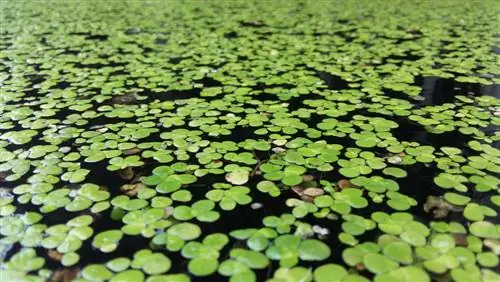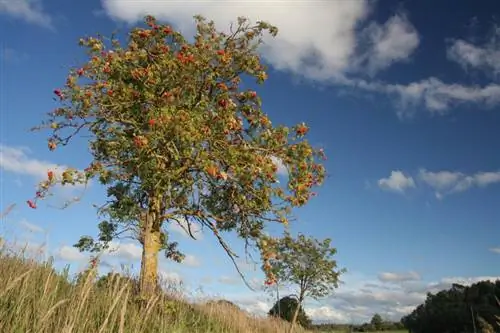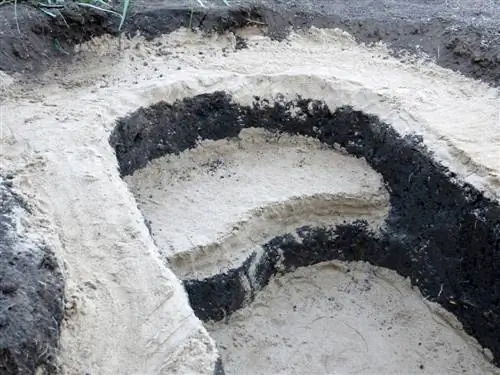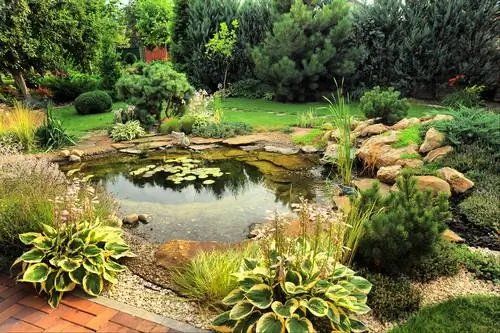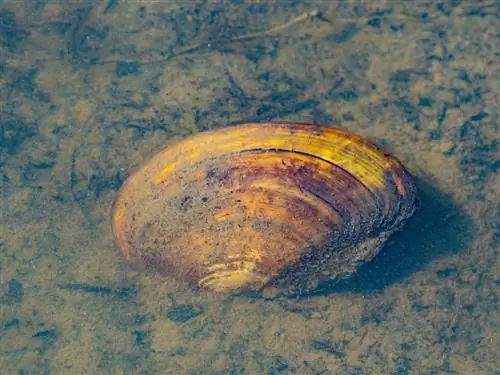- Author admin [email protected].
- Public 2023-12-26 14:17.
- Last modified 2025-06-01 06:02.
Duckweed is probably familiar to every reader, after all, in summer many garden ponds are almost completely covered with the tiny aquatic plants. You can find out in this article what advantages duckweed has and when you need to contain the population and how.
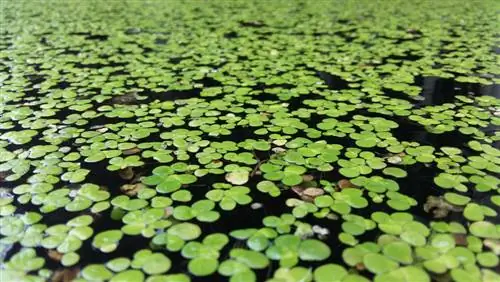
What is duckweed and what properties does it have?
Duckweed is the popular name for duckweed, a fast-growing aquatic plant that thrives on calm, nutrient-rich waters. It improves water quality, serves as food for animals and is effective against algae. However, it can also contain pollutants and displace other aquatic plants.
- Duckweed is the popular name for duckweed, of which the small duckweed is particularly common on calm waters.
- Duckweed grows on calm and nutrient-rich waters.
- They get their popular name because ducks and other waterfowl love to eat them. Just like some fish, e.g. E.g. carp and rudd.
- Duckweed purifies heavily polluted waters and is sometimes used to feed pigs and chickens.
- However, the plants also spread very quickly and can upset the ecological balance.
What is duckweed?
Of course, the term “duckweed” (some might say duckweed) is not the official name of the plant. The aquatic plant is correctly called small duckweed (Lemna minor) and belongs to the arum family (Araceae). There are also 14 other types of duckweed in Germany. The plant is only popularly called “duckweed”. It is called that because ducks and other pond inhabitants love to eat them.
Features and Appearance
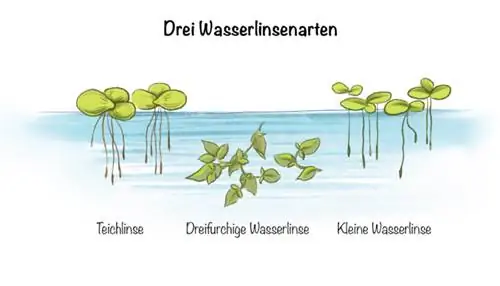
The individual plants are tiny: Each plant consists of one to five small, usually oval leaves, each with a maximum diameter of eight millimeters. These leaves float freely on the surface of the water thanks to air-filled cavities. The plant root extends into the water. It not only serves to absorb minerals and other nutrients, but is also intended to stabilize the leaves.
The small duckweed reproduces mainly asexually by sprouting, i.e. H. A new shoot grows out from the side of a mother plant. This can remain connected to the mother plant, but can also separate. In this way, duckweed multiplies rapidly if the conditions are right - the more nutrient-rich a pond, the faster it becomes covered with a green carpet. The duckweed population can double every three days, and sometimes the plants can do so even faster.
Does duckweed bloom?
In fact, duckweed can flower, but this only happens very rarely - asexual reproduction is simply too successful for that. The very small flowers appear between May and June and are pollinated by insects such as spiders and water striders, but also by snails and even by water movement. Tiny nuts containing one to several seeds then form. These in turn spread through movements of the water and through aquatic animals, e.g. E.g. fish or ducks.
Habitat, occurrence and distribution

Duckweed prefers standing water
Duckweed grows exclusively on stagnant or slow-flowing freshwater bodies of water. The aquatic plant is typically found in pools and ponds as well as on streams and in sewage and drainage ditches - the main thing is that the water in them is calm and contains a lot of nutrients. The aquatic plant can even be found in polluted waters or waters contaminated with sewage. It can be found in temperate climate zones almost all over the world and has even been introduced to Australia and New Zealand.
Duckweed in the garden pond - care and containment
If you want to establish the small duckweed in your pond or aquarium, you don't have to do much: the plant doesn't have too high demands and reproduces quickly. In fact, duckweed grows like a weed in almost any condition:
- Light requirements: sunny to partially shaded
- Water temperature: 0 to 32 degrees Celsius
- pH value: 3, 2 to 10
- Hardness: 2 to 30
In fact, when caring for it, it is important to note that you have to limit growth from time to time so that the ecological balance in the pond does not tip. If the duckweed covers the entire surface, other aquatic plants suffocate or perish due to a lack of sunlight. Ultimately, with this dense, green carpet, not enough sunlight reaches the pond and the plants growing below the water surface.
Water quality
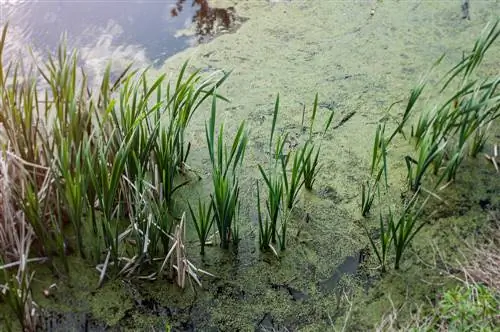
Duckweed grows where other plants have no chance
The small duckweed (and other duckweeds) are often placed in water bodies contaminated with sewage or agricultural activity due to their water-purifying properties. Here the plants reproduce very quickly due to the high nitrogen and phosphorus content and at the same time remove these excess nutrients from the water. This means that duckweed also grows where other aquatic plants have no chance.
Thus, duckweed has valuable ecological value by cleaning damaged and dumped water bodies. These can then also be used for other aquatic creatures such as more sensitive aquatic plants, fish, frogs and other amphibians, aquatic snails, etc. Of course, this also works in the garden, for example if the neglected pond needs to be cleared of algae and made habitable again. Thanks to their absorbent properties and rapid growth, duckweed displaces unwanted algae growth, which is particularly evident in waters rich in nitrogen and phosphorus.
Wintering
You don't have to worry about anything when it comes to wintering. Duckweed is a perennial plant that stores starch as a reserve in the fall. They then sink to the bottom of the water and spend the winter months there. As soon as it gets warmer again in spring, the plants will rise again and spread again.
Containment
To prevent the pond from becoming overgrown with duckweed, you should install the following measures to curb growth at an early stage:
- do not fertilize if growth is strong
- make sure that fertilizers can also be washed into the garden pond from the surrounding beds
- Use fish as natural “predators” of duckweed
- Carp (e.g. Koi) are particularly suitable
- However, this only works if the pond is large enough
- Caution: Fish food is fertilizer for duckweed!
- Keeping ducks or geese on the waterfront property
- of course this only works if you have the space and leisure for it
- install a fountain in the middle of the pond
- this ensures water movement and so that duckweed spreads less quickly
- Fishing duckweed with a landing net
Don't try to fish out the duckweed with your bare hands - the duckweed will stick to you everywhere. It's easier with a landing net (€17.00 on Amazon) (like the one you use for fishing).
Excursus
Duckweed in the aquarium - what you can do about it
Duckweed can also quickly become a problem in the aquarium, which is why the plant is not particularly popular with many aquarium enthusiasts despite its positive properties. Here, too, you have to curb growth through sparing fertilization (be careful with fish food!) and regular raking.

Using Duckweed - Advantages and Disadvantages
Are you also faced with the question of whether or not you should plant duckweed in your garden pond? The following list of advantages and disadvantages of this aquatic plant may help you make your decision.
1. Advantage: Improve water quality
Duckweed cleans polluted water and is therefore often used for the ecological cleaning of water polluted by agricultural wastewater. This is the case, for example, with bodies of water that are located near fields fertilized with manure. There are numerous projects, particularly in developing and emerging countries, in which wastewater is purified with duckweed and the clean water obtained is ultimately used to irrigate vegetable fields and the harvested, nutrient-rich duckweed is used to feed chickens, pigs and other farm animals.
But how does water purification with duckweed work? This is easily explained: The rapidly multiplying plants primarily remove nitrogen and phosphorus, but also other organic substances, from the nutrient-rich water. They also filter out other substances, such as heavy metals, and store them in their biomass. As soon as the duckweed is skimmed off, the harmful substances are finally removed from the water.
2. Advantage: Algae killer
Duckweed is also considered a good algae killer because the plant deprives the algae of their livelihood - there are simply not enough nutrients left for the algae to spread further. This fact is of particular interest for the organic management of garden ponds and in aquarium keeping.
3. Indicator of iron deficiency

If the duckweed turns yellow, the water lacks iron
The use of duckweed as an indicator of iron deficiency is also particularly relevant in aquaristics. If the water contains too little iron, the leaves turn yellow very quickly. Using this color, you can recognize an iron deficiency in good time, before fish or other aquatic plants suffer from it, and can quickly take countermeasures.
4. Advantage: Robust and undemanding
Duckweed is extremely robust and can withstand both severe frost and heat up to 32 °C. Even water with an acidic pH value doesn't bother the plants at all. For these reasons, duckweed grows practically everywhere.
5. Advantage: animal feed
Surprisingly, duckweed contains a high level of valuable proteins. When it comes to amino acids, this inconspicuous plant can even compete with the much-vaunted soybean. It's no wonder that duckweed is increasingly being used to feed pigs and poultry - it's cheap to buy and full of valuable nutrients.
Excursus
Duckweed - a food of the future?
For exactly the same reason, some scientists consider duckweed to be the food of the future: quick and sustainable to produce, quickly available and full of valuable proteins. However, the renowned food chemist Udo Pollmer believes this to be nonsense; after all, the information on nutrients refers to the dry matter - and duckweed also absorbs a lot of toxic pollutants like a sponge. So stay away!
1. Disadvantage: content of pollutants
And duckweed actually absorbs all kinds of poisons from wastewater: the biomass of the plants often contains substances such as arsenic, cadmium, radium, dioxins, residues of drugs and pesticides as well as algae poisons. The aquatic plant also produces oxalic acid, which is supposed to protect against predators such as water snails. Oxalic acid is also harmful to humans. Therefore, use as human food or animal feed should be reconsidered, at least if the duckweed grew in heavily polluted waters.
2. Disadvantage: Displacement of other aquatic plants
It is not without reason that many gardeners view duckweed as a weed; after all, the plants multiply very quickly and are difficult to keep in check. If the vegetation becomes excessive, the plant changes the pond's ecosystem: the oxygen content of the water decreases, as does the incidence of light - which in turn has negative effects on other aquatic plants and many fish - such as trout. If you don't take countermeasures in time, the pond threatens to silt up.
Frequently asked questions
Where does duckweed come from?
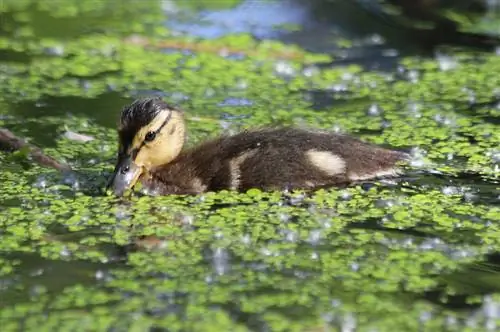
Ducks like to eat duckweed
The duckweed, colloquially known as “duckweed,” occurs almost all over the world in stagnant or calm fresh waters, where they are usually introduced unintentionally - for example by ducks and other water birds that carry the tiny plants from one pond to another transmitted. Duckweed also usually ends up in aquariums by accident, for example through contamination or through use in pond water. Even those who consciously plant duckweed will soon experience a surprise: if the conditions are right, the plants multiply rapidly and can double in size within just three days.
Is duckweed good for the pond?
This question can only be answered with “partly, partly”. On the one hand, duckweed is a high-quality source of food for many pond inhabitants (in addition to ducks and geese, fish also like to eat the plants), duckweed also absorbs pollutants from the water and thereby purifies it. These in turn also accumulate in the meat of fish and waterfowl, which in turn can be problematic for humans. In addition, the aquatic plant tends to spread very quickly and very drastically - with the result that it displaces other aquatic plants and thus upsets the ecological balance.
Can you also buy duckweed?
Yes, you can buy duckweed, especially in shops that specialize in aquariums and in online shops. In addition to Lemna minor, other related species are also available here.
Can duckweed also be used as fertilizer?
Rapid growth of duckweed indicates that it is a nutrient-rich body of water from which the plants mainly extract phosphate and nitrogen, but also other nutrients. To curb the growth of the duckweed, you should skim it from time to time. Then let them dry a little and use them as valuable green manure on vegetable or ornamental plant beds.
Can I feed my chickens duckweed?
In fact, you can feed duckweed (dried or freshly fished) to your chickens - they will be only too happy to eat the extremely protein-rich aquatic plant. Chicken owners with pond property may have already had this experience, as the poultry pounce on duckweed wherever it reaches them. However, be careful not to feed duckweed from sewage or overturned water - the pollutant levels are too high here and can harm the animals.
Tip
Ducks and fish alone cannot keep duckweed growth at bay, the plant simply grows too quickly. So you definitely have to net it or clean the pond thoroughly in the spring when the plants come back to the surface.

